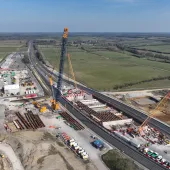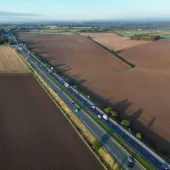HS2 reaches major concrete milestone
HS2 has reached an important milestone in the West Midlands, with over one million cubic metres of concrete now poured for the construction of key railway structures. This marks more than half of the 1.9 million cubic metres needed to complete the 90km stretch of viaducts and bridges along the route.
The concrete is being supplied by Aggregate Industries, Tarmac, and Cemex, who are working closely with HS2’s civils contractor Balfour Beatty VINCI (BBV). These suppliers are keeping concrete delivery schedules on track, ensuring that over 250 jobs are supported in the region through local batching plants. Eleven plants are supplying concrete to the project, five of which are directly on HS2 construction sites.
Jon Knights, materials and durability lead at HS2, commented: “The operation to manage the materials needed to build HS2’s structures is hugely complex, so this milestone is a great achievement for the whole team. With more than half the concrete poured for structures in the West Midlands, we’re well on the way to completing the viaducts and bridges that will carry the country’s new high-speed railway through the region.”
BBV has implemented a number of strategies to reduce carbon emissions in the concrete supply. The project uses low-carbon concrete mixes, with high proportions of ground granulated blast furnace slag (GGBS) replacing part of the cement content. The mix designs aim to reduce both carbon emissions and costs. Additionally, two of the project’s batching plants now use semi-battery technology to help lower their environmental impact.

The use of digital technology has also been a key part of the project’s strategy. BBV has introduced VERIFI, a real-time monitoring and measurement system for fresh concrete, which helps to minimise waste and improve productivity during transportation.
Chris Jones, senior construction manager at Balfour Beatty VINCI, said: “The planning, communication and logistics management needed to achieve this milestone cannot be underestimated. Working in partnership with our three concrete suppliers, the team has kept this massive operation moving, supporting delivery of HS2’s construction programme in the region. Carbon reduction is a big part of our materials strategy, and we’ve worked closely with our supply chain to minimise the total cementitious content in order to cut carbon and cost.”
The milestone was marked at the Chattle Hill structure at Delta Junction in North Warwickshire, where 4,100 cubic metres of concrete have already been poured out of the 10,200 cubic metres required for the structure. The Chattle Hill structure will carry four HS2 tracks over the A446 Lichfield Road on the mainline between London and Handsacre.
The wider project involves constructing a network of 13 viaducts in the North Warwickshire area, crossing roads, railways, and rivers. The A446 diversion, which will allow the road to pass under the new Chattle Hill structure, was completed at the end of October 2024, and the second phase of construction is now underway.
With construction progressing well, HS2 continues to advance its high-speed rail link between London and the West Midlands, supporting over 31,000 jobs in total. When complete, HS2 will connect London to the West Midlands on a dedicated high-speed line, before extending to northern destinations via the existing West Coast Main Line.








